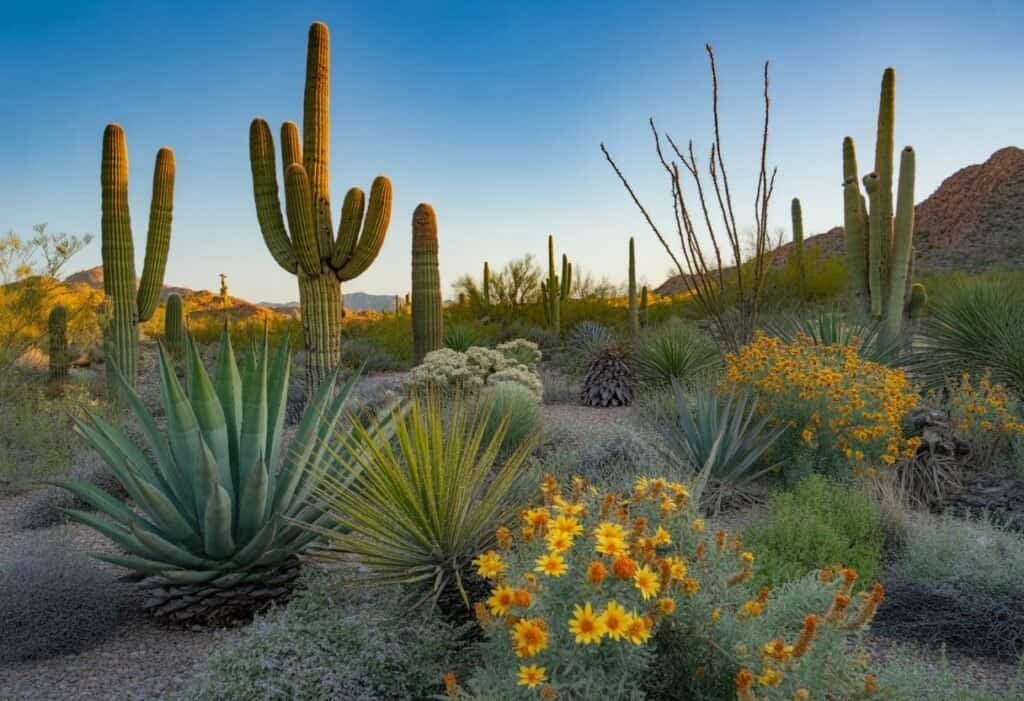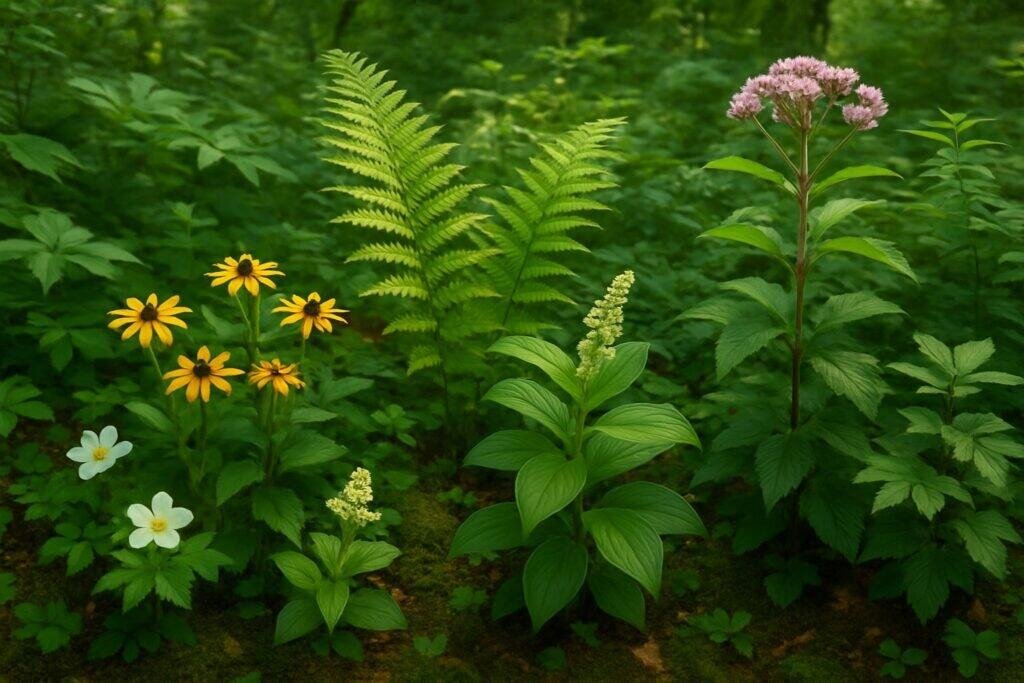Arizona’s native plants thrive in the harsh desert climate, offering beauty and resilience. These plants evolved over thousands of years to survive with minimal water and support local wildlife.
Using native plants in your Arizona garden saves water, reduces maintenance, and creates a natural ecosystem that supports local biodiversity.
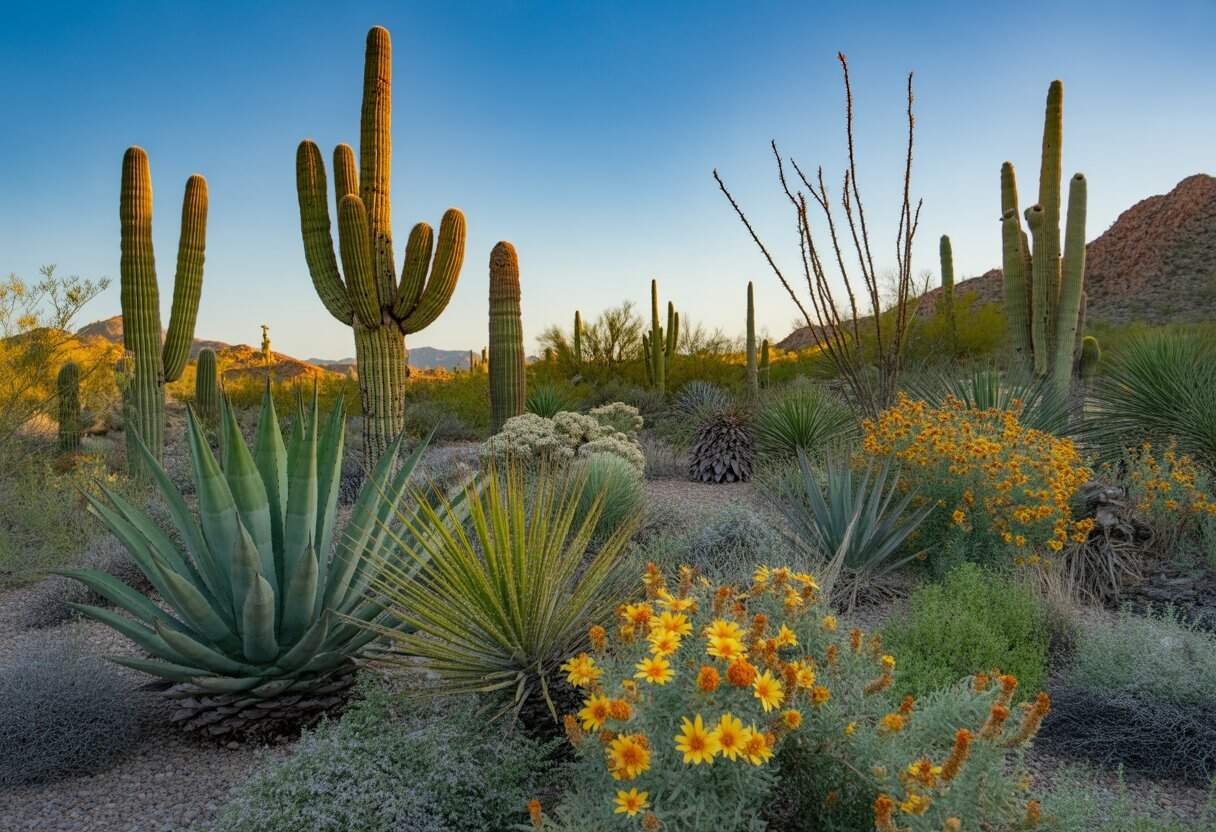
Native plants come in many forms, from saguaro cactus to colorful wildflowers and drought-resistant shrubs. They use adaptations like waxy coatings, small leaves, and deep roots to handle extreme temperatures and little rainfall.
Many native plants bloom throughout the year, adding color to the desert.
Key Takeaways
- Arizona native plants need less water and maintenance than non-native species and provide habitat for local wildlife.
- Native plant gardens support pollinators and help with regional conservation.
- Botanical gardens and native plant societies offer resources to help homeowners choose suitable species.
Overview of Arizona Native Plants
Arizona’s landscape features a wide variety of native plants that can handle its tough climate. These plants play important roles in the local ecosystem and have unique adaptations for arid conditions.
Defining Native Plants
Native plants are species that evolved naturally in a region without human help. In Arizona, native plants include those present before European settlement.
These plants match Arizona’s soil, rainfall, and temperature patterns. The Arizona Native Plant Law protects many species from collection without permits, including saguaro cacti, palo verde trees, and ocotillo.
Native plants need less water, fertilizer, and maintenance than non-native ornamentals. Introduced or invasive species often require more resources and can disrupt local ecosystems.
Ecological Significance in Arizona
Native plants form the foundation of Arizona’s ecosystems. They provide food and shelter for wildlife, including over 500 species of native bees, butterflies, birds, and mammals.
Many Arizona animals have co-evolved with specific plants. For example, the lesser long-nosed bat depends on saguaro and agave flowers for nectar and helps pollinate these plants.
Native plants prevent erosion with deep roots that hold soil during monsoon rains. This is important in deserts where soil recovers slowly.
These plants also filter runoff and help recharge groundwater supplies, which is vital in Arizona’s dry climate.
Adaptations to Arid Environments
Arizona native plants use special adaptations to survive heat and drought. These strategies differ among plant types.
Water Conservation Techniques:
- Succulent stems and leaves store water (cacti, agave).
- Small, waxy leaves reduce water loss (creosote bush).
- Deep taproots reach groundwater (mesquite trees).
Many desert plants use thorns or toxins to protect their stored water from animals. Some, like ocotillo, stay dormant during drought and quickly grow leaves after rain.
Desert wildflowers complete their life cycle during short rainy periods. Native grasses and shrubs may drop leaves during dry times but keep roots alive underground.
Common Types of Arizona Native Plants
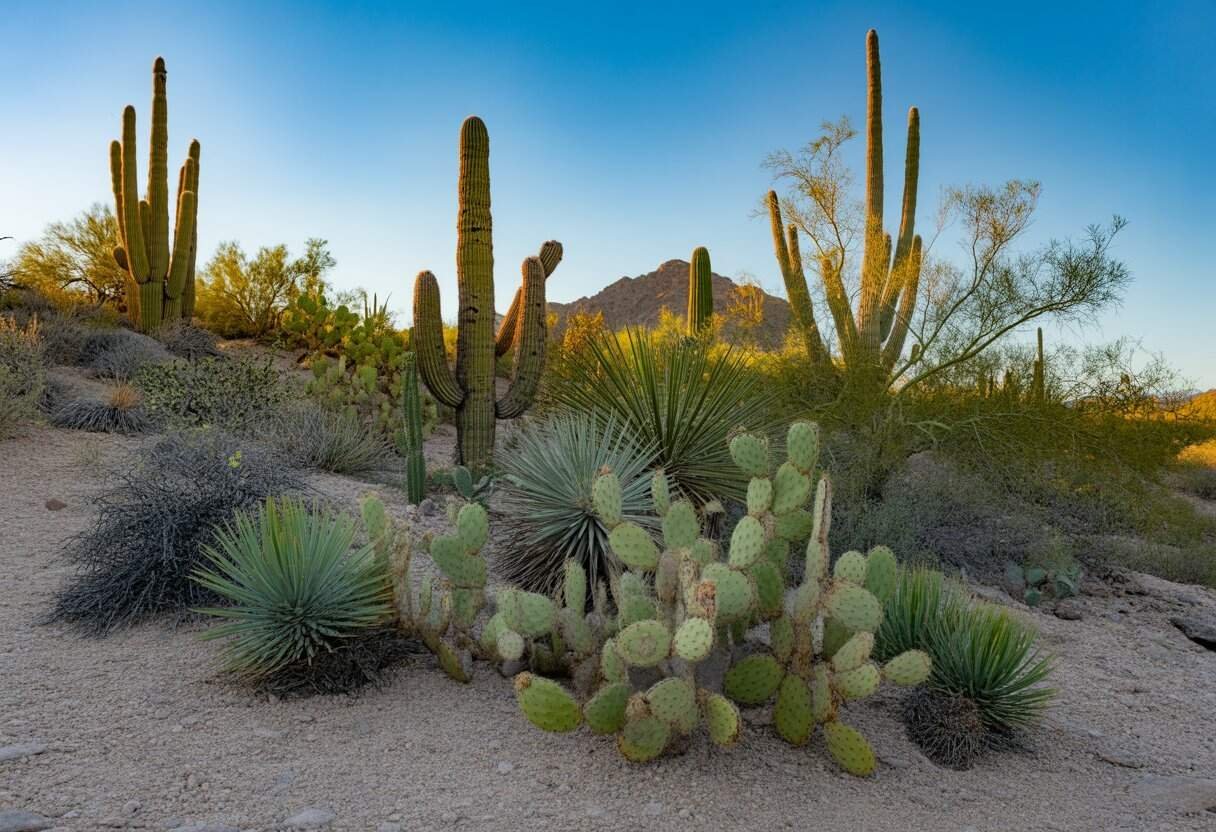
Arizona’s landscape includes many native plants that thrive in desert conditions. These plants use little water and can handle extreme temperatures, while supporting local wildlife.
Wildflowers and Grasses
Desert marigold adds yellow blooms to Arizona’s landscape year-round, peaking in spring. These tough flowers attract butterflies and other pollinators.
Blue grama grass forms clumps with seed heads that look like eyebrows. This drought-resistant grass supports Arizona’s grasslands.
Desert lupine grows purple-blue flower spikes in spring and improves soil quality naturally. Brittlebush creates yellow carpets across the desert after winter rains.
Its silvery leaves reflect sunlight and help reduce water loss. Mexican gold poppy covers hillsides in gold after good winter rain, completing its life cycle before summer heat.
Cacti and Succulents
Saguaro cactus stands as Arizona’s most famous plant, growing up to 40 feet tall and living 150-200 years. These cacti grow arms after about 75 years.
Barrel cactus has bright red or yellow flowers on top of its round body. It often leans southwest, earning the nickname “compass cactus.”
Prickly pear produces edible fruits called “tunas” and flat pads (“nopales”) used in cooking. Its flowers appear in spring and come in yellow, orange, or pink.
Agave plants have thick, pointed leaves in a rosette shape. After 10-30 years, they send up a tall flower stalk and then die, which is why people call them “century plants.”
Ocotillo, a drought-deciduous shrub, grows spiny stems that leaf out after rain and shed leaves when dry.
Trees and Shrubs
Mesquite trees offer shade with wide canopies and deep roots that reach groundwater far below the surface. Palo verde trees have green bark that photosynthesizes when they drop leaves during drought.
Their yellow flowers bloom each spring. Creosote bush is common in Arizona deserts and can live for thousands of years, giving off a unique smell after rain.
Desert ironwood acts as a nurse plant for young saguaros, protecting them with its dense canopy. Its wood is so heavy it sinks in water.
Jojoba shrubs make seeds rich in oil, used in cosmetics and industry. Their bluish-green leaves help them save water.
Designing a Desert Garden with Native Plants
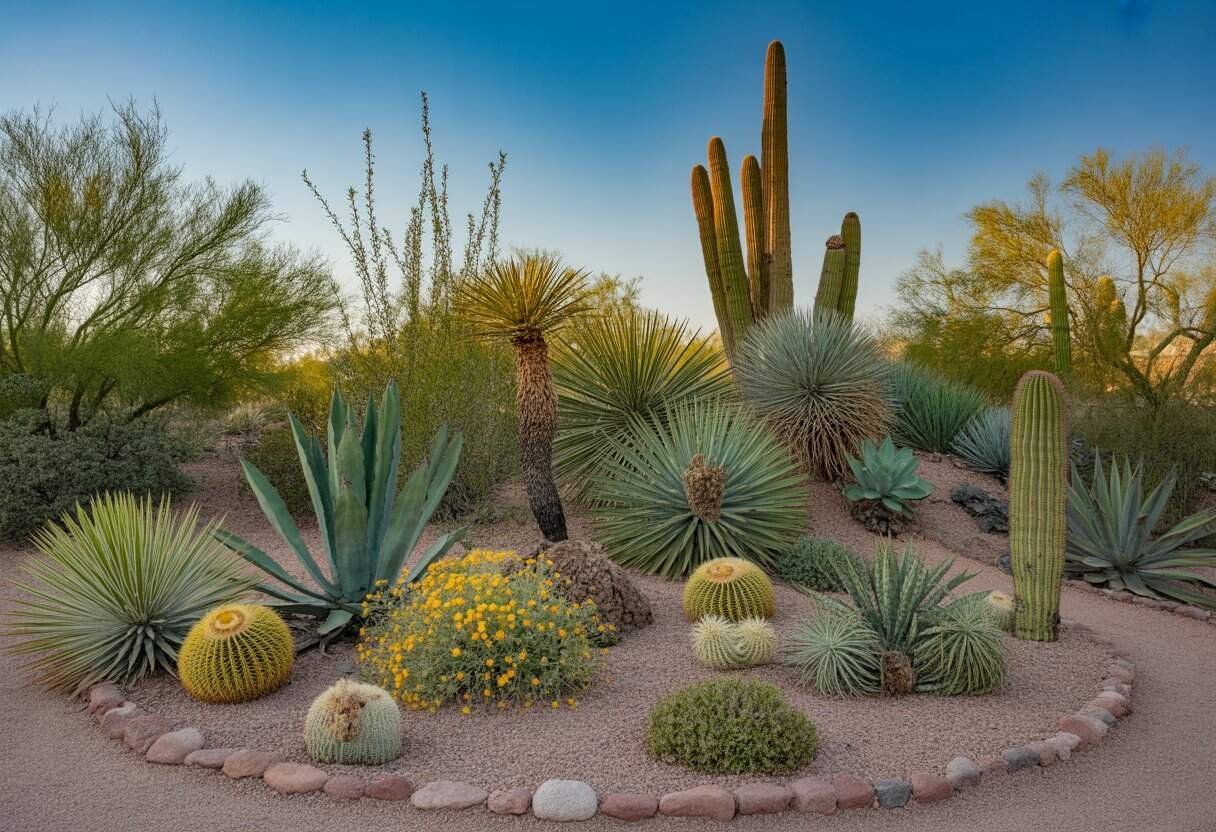
A beautiful desert garden with Arizona’s native plants conserves water and supports local wildlife. Native plants need less maintenance after they become established.
Planning and Layout
Observe your property’s natural features, noting sunny and shady spots, drainage, and existing plants. Group plants with similar water needs together using hydrozoning.
Choose a mix of plants for year-round interest. Combine trees like palo verde or mesquite for shade with shrubs such as brittlebush or creosote.
Add color with penstemons, desert marigolds, and globe mallow. Use permeable materials like decomposed granite or flagstone for paths to let water soak into the soil.
Space plants based on their mature size. Many desert plants need more room than expected because of large root systems.
Soil and Watering Considerations
Desert soils often lack organic matter and nutrients. Add compost to planting holes but not the whole bed to encourage roots to grow into native soil.
Install a drip irrigation system for efficient watering. Place emitters at the edge of each plant’s canopy.
Water deeply but not often to help roots grow deep. New plants need regular water for the first year, but most natives do well with little irrigation once established.
Apply a 2-3 inch layer of mulch to keep moisture in and stop weeds. Use decorative rock or gravel as mulch away from buildings to reduce fire risk.
Test soil drainage by digging a hole, filling it with water, and timing how fast it drains. Most desert plants like well-drained soil.
Shrubs and Their Role in Arizona Landscapes
Native shrubs shape Arizona’s desert landscape, providing structure and ecological benefits. They survive with little water and help local wildlife.
Top Native Shrub Species
Creosote bush dominates many Arizona areas and gives off a special smell after rain. This tough shrub can live for thousands of years and spreads by cloning itself.
Brittlebush shows off bright yellow flowers in spring. Its silvery leaves reflect sunlight and help save water.
Desert hackberry offers shade and edible berries that attract birds. It grows 3-10 feet tall and works well as a screen in yards.
Fairy duster adds color with pink or red puffball flowers. This drought-tolerant shrub needs almost no care once it is established.
Jojoba makes oil-rich seeds and stays green all year. Its deep roots reach groundwater other plants can’t access.
Wildlife Habitat Creation
Native shrubs give shelter to Arizona wildlife. Dense branches protect small mammals and birds from predators and harsh weather.
Many shrubs make berries, seeds, or nectar that feed local animals. Coyotes, jackrabbits, and quail use these food sources during tough times.
Shrubs create cooler, more humid microhabitats than open desert. These spots help sensitive species survive.
Flowering shrubs like wolfberry and desert lavender attract pollinators such as bees, butterflies, and hummingbirds. These animals rely on nectar from shrubs throughout the year.
The roots of native shrubs stop soil erosion during monsoon rains, helping the whole ecosystem.
Supporting Pollinators with Arizona Native Plants
Arizona native plants and local pollinators have developed a close relationship over thousands of years. These plants provide food and shelter for bees, butterflies, hummingbirds, and other helpful species.
Pollinator-Friendly Native Species
Several native plants support pollinators well. Parry’s penstemon (Penstemon parryi) has bright pink flowers that attract hummingbirds and native bees.
This drought-tolerant perennial blooms from late winter through spring. Desert marigold (Baileya multiradiata) offers yellow flowers that butterflies love and provides nectar from spring to fall.
Chuparosa (Justicia californica) stands out as a hummingbird favorite with red flowers in winter when other nectar is rare. Desert milkweed (Asclepias subulata) is a key host for monarch butterflies.
Monarch caterpillars feed only on milkweed leaves, and adult butterflies use the nectar.
Top Pollinator Plants by Season:
- Spring: Brittlebush, Desert lupine
- Summer: Globemallow, Desert willow
- Fall: Arizona sunflower, Turpentine bush
- Winter: Fairy duster, Chuparosa
Attracting Beneficial Pollinators
A pollinator-friendly garden needs more than plants. Pollinators also require water, shelter, and chemical-free spaces.
Provide a shallow water dish with pebbles for bees and butterflies to drink safely. Mud patches help mason bees gather materials for nests.
Plant in clusters of three or more to create visible landing pads for pollinators. This attracts more pollinators than single, scattered plants.
Choose plants with different bloom times to supply food all year for pollinators. Avoid pesticides, as they harm pollinators and contaminate nectar and pollen.
Encourage natural predators like ladybugs and praying mantises to control pests. Leave some bare ground for ground-nesting bees, which make up about 70% of native bee species in Arizona.
These solitary bees rarely sting and are excellent pollinators.
Conservation and Sustainable Landscaping
Using Arizona native plants in landscaping helps preserve water and support local wildlife. These plants have adapted to the harsh desert conditions over thousands of years.
They require fewer resources to thrive. Native plants need significantly less water than non-native species.
Once established, many Arizona natives need little to no supplemental irrigation. This can save up to 70% of landscape water usage.
They also need fewer fertilizers and pesticides. Plants like creosote bush and brittlebush naturally repel many pests common to the region.
Native landscapes support local wildlife by providing familiar food sources and habitats. Penstemon species attract hummingbirds, while desert marigold brings in butterflies and bees.
Maintenance requirements drop with native plants. Most need only occasional pruning and minimal care compared to exotic species.
Economic benefits include:
- Lower water bills
- Reduced maintenance costs
- Fewer replacement plants needed
- Potential rebates from water conservation programs
Restoration of Native Habitats
Habitat loss threatens many Arizona plant communities. Urban development has removed thousands of acres of desert habitat.
Native plant restoration helps reverse this damage. Planting natives in disturbed areas helps prevent erosion.
Their deep root systems stabilize soil, which is important during Arizona’s monsoon season.
Key restoration plants include:
- Mesquite trees
- Palo verde
- Desert willow
- Various cacti species
- Native grasses like deer grass
Community restoration projects are growing across Arizona. Schools, businesses, and neighborhoods are converting areas back to native landscapes.
These projects create wildlife corridors through urban areas. Even small native gardens help species move between larger natural areas.
Resources for Arizona Native Plant Enthusiasts
Arizona offers many resources for people interested in native plants. Local nurseries sell native species, and organizations provide education about desert gardening.
Local Nurseries and Botanical Gardens
Desert Survivors Nursery in Tucson specializes in Sonoran Desert native plants. They offer cacti, shrubs, and wildflowers adapted to Arizona’s climate.
The Desert Botanical Garden in Phoenix maintains over 50,000 plants across 140 acres. Their plant shop sells natives, and they host seasonal plant sales with hard-to-find desert species.
Boyce Thompson Arboretum near Superior showcases native plants in natural settings. Their nursery offers plants propagated on-site, and expert staff answer questions.
Native Seeds/SEARCH in Tucson preserves and sells seeds of traditional crops from the Southwest. They offer seeds for native food plants like tepary beans and desert chia.
Educational Organizations and Publications
The Arizona Native Plant Society provides workshops, field trips, and plant identification training. Their website features guides to common natives and restoration techniques.
The University of Arizona Cooperative Extension publishes free guides about native landscaping. Their “Desert Landscaping Plants” series includes care instructions for common species.
Popular books include:
- Arizona Native Plants by Carol Crosswhite
- Landscaping with Native Plants of the Southwest by George Miller
- Plants of Arizona by Anne Epple
Online resources like AmericanSouthwest.net feature plant identification guides with photographs. The Arizona-Sonora Desert Museum website provides information about native plant communities and growing requirements.
Frequently Asked Questions
Arizona’s native plant life includes diverse species adapted to harsh desert conditions. These plants support local wildlife and offer sustainable landscaping options.
What are the most common native plants found in the Arizona desert?
The Saguaro cactus is Arizona’s most iconic native plant. It grows up to 40 feet tall and lives for 150-200 years.
These giants dot the Sonoran Desert landscape and provide habitat for many desert animals. Palo Verde trees, with their green bark, serve as Arizona’s state tree.
They offer filtered shade with small leaves that minimize water loss. Creosote bush dominates large areas of Arizona desert.
This hardy plant releases a distinctive scent when it rains. Other common natives include ocotillo, brittlebush, desert ironwood, and various cholla and prickly pear cacti.
Where can one find high-quality photos of Arizona’s indigenous flora?
The Arizona-Sonora Desert Museum maintains a digital collection of native plant photographs. Their website features searchable galleries by plant type.
Desert Botanical Garden in Phoenix offers a photo database of their native plant collection. Many images show plants in different seasons and growth stages.
The University of Arizona Herbarium provides scientific photographs of preserved plant specimens. These images help with precise identification of native species.
Nature photographers like Jack Dykinga and John P. Schaefer have published books featuring Arizona plant photography.
Which Arizona-native plants are suitable for drought-tolerant landscaping?
Desert marigold creates bright yellow flowers that attract pollinators and needs minimal water. These perennials reseed easily, maintaining their presence in the landscape.
Penstemons, especially Parry’s penstemon, thrive in desert conditions. They bloom in spring and add vibrant color to gardens.
Brittlebush produces silver-gray foliage and yellow daisy-like flowers. This drought-hardy plant needs almost no supplemental water once established.
Fairy duster shrubs offer red feathery flowers that attract hummingbirds. They grow slowly but tolerate extreme heat and drought.
Desert spoon (Dasylirion wheeleri) adds architectural interest with spiky blue-gray foliage. This accent plant withstands full sun and minimal water.
How can enthusiasts purchase native plants indigenous to Arizona?
Native plant nurseries like Desert Survivors in Tucson and Desert Native Plants in Phoenix grow and sell local species. These nurseries offer advice on plant selection and care.
The Desert Botanical Garden holds seasonal plant sales featuring native species. Their spring and fall sales provide access to unusual varieties.
Local chapters of the Arizona Native Plant Society organize member plant exchanges and sales. These events often feature rare natives grown by experienced gardeners.
County extension offices partner with master gardeners to hold plant sales focused on region-appropriate natives. These plants are usually well-adapted to local conditions.
What resources are available for identifying native plants in Arizona?
The book “Desert Plants of Arizona” by Anne Orth Epple is a standard reference with color photographs and detailed descriptions. It includes information on habitat and bloom times.
The Arizona Native Plant Society offers field guides, workshops, and guided hikes to help with identification. Their website provides downloadable plant lists by region.
iNaturalist’s Arizona native plants project lets users upload plant photos for community identification. The app uses location data to narrow possible species matches.
The University of Arizona Cooperative Extension publishes free plant identification guides by region and plant type. These resources include native trees, shrubs, and wildflowers.
What shrubs are native to Arizona and suitable for residential landscapes?
Desert hackberry grows 15-20 feet tall and has edible berries that attract birds. This drought-tolerant shrub provides dappled shade in home landscapes.
Jojoba offers evergreen foliage and grows slowly to about 6 feet. Its waxy leaves stay attractive year-round and need little water.
Chuparosa produces tubular red flowers that attract hummingbirds during warm months. This shrub reaches 4-5 feet tall and tolerates heat from walls and pavement.
Arizona rosewood forms a formal hedge or small tree with fragrant white flowers in spring. Its dense growth provides privacy and wind protection.
Wolfberry shrubs produce small edible berries similar to goji berries. These thorny natives grow 3-4 feet tall and attract birds and beneficial insects.

